
Expeditions: Rome Review
I was not originally planning on playing Expeditions: Rome. Nothing about the setting really captivated me, I thought the marketing ahead of the game was fairly dry and uninteresting, and the strategy and RPG hybrid didn't seem like a good fit -- though maybe that was just my penchant for more traditional CRPGs talking at the time.
Against my hasty judgment, however, I (thankfully) decided to play through this fictional historical tale of a legatus during Rome's campaigns in Asia Minor, Egypt, and Gaul in the first century BC. The more that I played and allowed myself to engage with what Expeditions: Rome had to offer, the more I found myself wanting to share about my experience that had come so close to flying under my radar.
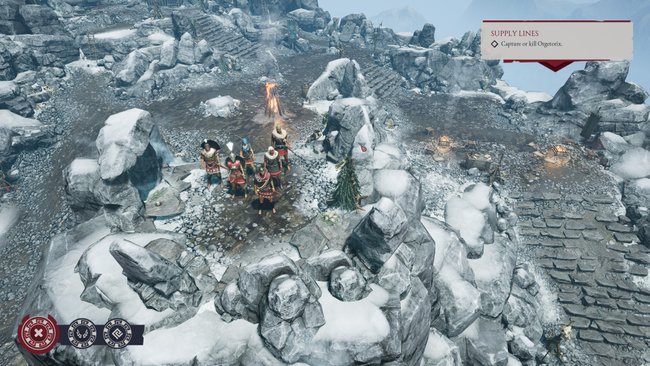
After a short introduction that explains the context of the player-character's quick insertion into one of Rome's most respected legions, the game immediately opens up into gameplay without a lot of pomp or circumstance. Expeditions Rome has two major game modes that the game will skip between. At its core is a turn-based tactical RPG that plays similar to something like Wasteland 3, where combat takes place in phases between allied and enemy units. Controlling a squad of typically six units, each battle pits the player in unique combat situations with varying objectives. Each unit is assigned one of four classes, which then is further specialized into 3 subclass skill trees. Even by the final third of the game, I was still coming up with interesting ways to pair specific capabilities together due to the sheer amount of build variety available and possible team compositions.
The main storyline of the game will introduce the player to five named companions that serve to cover the full array of class options. While these five characters each have bespoke dialogue and sidequests alongside their direct involvement in the main narrative, up to 8 additional generic units can be hired to give full flexibility on exactly how the full squad is assembled (if you wanted to make a full squad of Assassins. for example). While the five main companions are required for most of the story battles, certain other battles only allow up to one of the main companions to lead the group, forcing the rest of the squad to be filled with these additional units. I grew to really appreciate this because it allowed me to come up with and try out some unorthodox team compositions that I wouldn't have been able or incentivized to if I was just able to use the main companions in each and every battle.
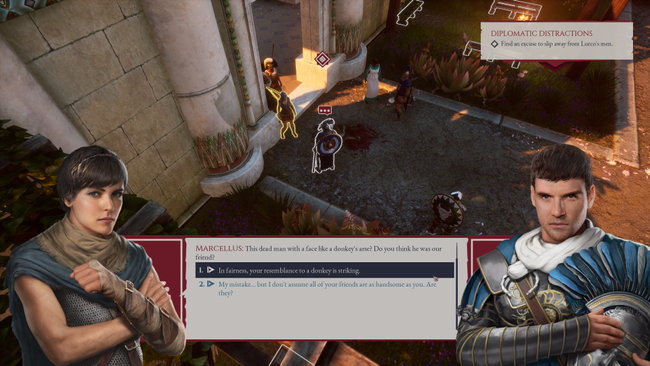
While I initially did not really find myself strongly endeared to most of the roster at the outset of the game during the first of three Acts, I surprised myself at the level of enjoyment I had witnessing the growth and change of some of the characters that formed over the course of the whole experience from that point on. Expeditions: Rome takes place over the course of several years, and as the length of the game itself can reach 40 to 50 hours before hitting the end credits, I found myself genuinely attached to these characters and specifically noticed myself making key decisions in the late game around ensuring as many survived as possible. The relationship between the ex-gladiator Bestia and the old mentor Syneros was a really compelling highlight of the game, and there was smart enough pacing alongside enough time spent with these characters to make the experience seem genuine and not hackneyed.
One particular character interaction that I thought carried through to the end of the game superbly was that between the main character and his companions and the primary antagonist Vitellius Lurco. While he starts out the game mostly on the fringes of the story, his involvement gets more integral and complicated as the years pass and the stage shifts from Asia to Egypt and finally Gaul. Instead of being outwardly evil or corrupt, most of the early interactions with him read instead like incompatible personalities rather than something truly hostile. The final main Act of the game even pits the player in an uncomfortable and uneasy alliance with Lurco, which made for a compelling dynamic just as the conflict between him and the cast began to come to a head. This slow escalation of tension and unease culminated in a satisfying final encounter that didn't have to resort to raising the stakes too high just to stand out from the rest of the game. Most of the characters also have strong voice talent that really sells the Mediterranean setting of the game, as well as the various cultures that each Act involves.
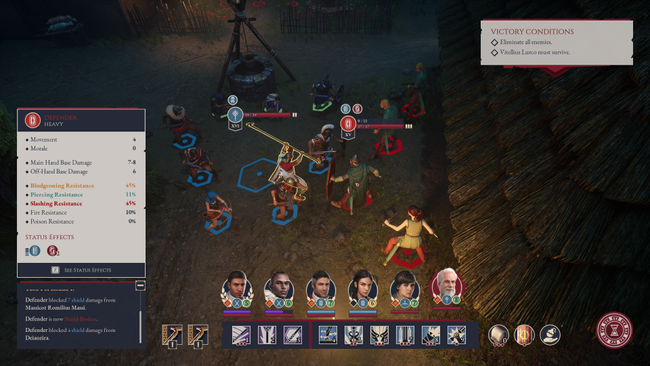
While the story and character dynamics were a pleasant surprise that I was not expecting, one major downside that hampered my enjoyment of Expeditions: Rome was the lack of convenient options when it came to micromanaging my units or legions with respect to gear and equipping items. Throughout the different campaigns, you'll pick up new armor and weapons in a sort of two-tiered rarity system. First: there's a quality metric for each item such as Worn, Regular, Good, or Pristine, and second: there's a specific numbered tier assigned to each piece of gear, such as a Gladius II being stronger than a Gladius I. The quality of a weapon determines the number of unique affixes it might have, while the tier represents an item's overall strength -- combined these make the total value of the equipment.
However, even though I like micromanaging in most games, the lack of good sorting options and clumsy UI made this a cumbersome chore every time I wanted to refresh my units' equipment. It's only possible to sort equipment by Old, New, or "Name", and not by rarity, tier, type, or any other fashion. On top of that, several moments in the game auto-unequipped my units' gear in order to serve the story in some fashion, meaning I would then have to dig through my gear pile in order to find what weapons I needed to replace onto each of my characters a few times. I also felt like I unlocked the capability to upgrade and modify gear too late in the game to really get a lot of mileage out of a gameplay system that could have bolstered my experience on this front. I often found myself chaining battles together until I found myself struggling before looking at upgrading gear, simply because I was putting off any management until the last possible moment because it never ceased to be frustrating.
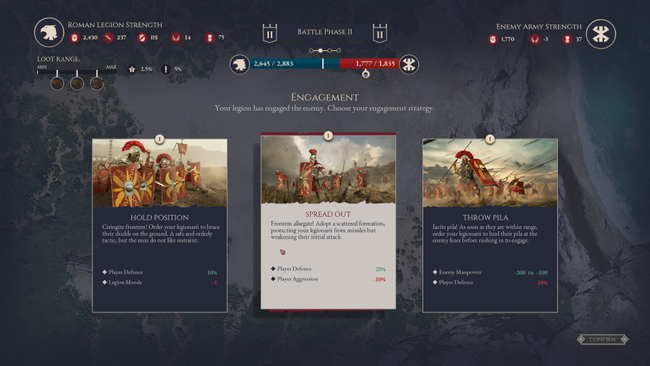
The other major gameplay component is the more strategic Legion Conquest mode, which takes place entirely on the World Map. These Legion battles are more Risk-like encounters that take place on the world map of the region of the current campaign. These are in concept a bit similar to the crusade battles of Pathfinder: Wrath of the Righteous, but I ended up enjoying these much much more. Instead of directly controlling units in battle, Legions are pitted against each other based on their overall strength, factoring in the number of soldiers, battle experience, morale, missing or injured units, and the capabilities of the Centurion chosen to lead the Legion.
From here, different strategies are selected that either cautiously defend your soldiers or more ambitiously go for a quick victory at the risk of potentially losing more lives or even a commander. These battles are usually snappy and can be fast-forwarded or auto-resolved in a manner that means they never overstay their welcome. New strategies can be unlocked throughout the course of the game, and occupying more territory is the primary way to get more resources to upgrade your camp.
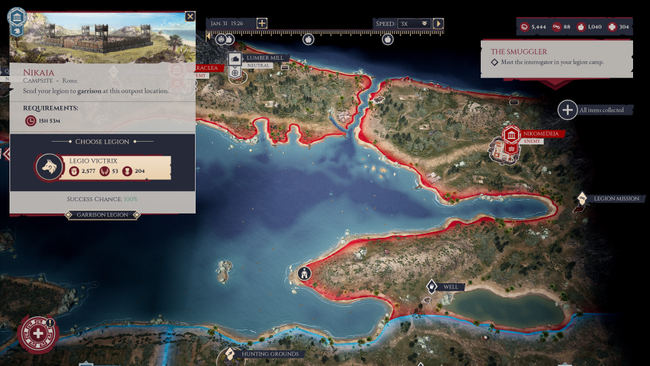
Unfortunately, on a Normal difficulty playthrough. I found that most of the gameplay components that latched into this aspect of the game ended up not factoring into my decision-making at all. While the player is asked to manage their resource counts such as currency and rations, I found that I never really had to concern myself with rations or medicine stores, and rarely dealt with a defeat in any Legion encounter. Whenever I did need these materials, a quick couple of stops at designated points on the map were all that was required to replenish what I needed for hours, and never had to trade resources through the game's market system.
It's likely that these elements would become more meaningful at higher difficulties, but I was enjoying the small-scale combat more in the first place anyway, so I allowed these legion fights to stay pretty easy as I focused on the more CRPG-like combat of the turn-based battles. Pacifying new regions does involve unique battles, often with interesting and varied objectives, so that alone was enough motivation for me to still try to get the most out of the Legion gameplay elements, regardless. All-in-all, I found that I was surprised at the extent that I ended up enjoying Expeditions: Rome. For the most part, it played more like a traditional CRPG than I expected, with the more strategy-like elements ending up being relatively minor features.
Expeditions: Rome is an easy recommendation for any fan of turn-based tactical RPGs. The variety of gameplay environments, the depth of the combat system, and a surprisingly compelling story with unexpectedly strong characters all carry the experience above the few shortcomings of clumsy UI and underwhelming strategy elements. Even if you have no attachment to the setting of ancient Rome (I sure didn't), the overall scope and level of ambition are worth experiencing first-hand.